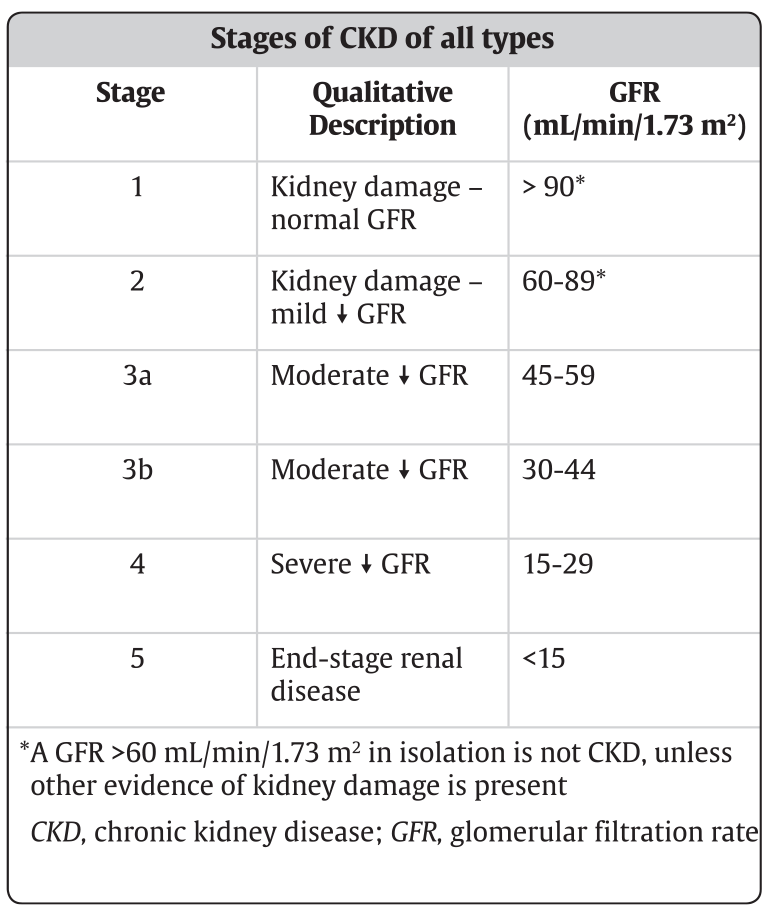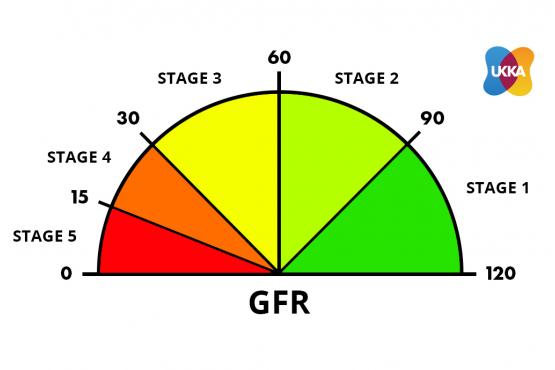Stage 4 CKD (with a GFR under 30 ml/min) – is when doctors get concerned about CKD. But it is not as simple as that (see later) [“is it ever?!” CKDEx Ed].
Let’s go through the 5 stages, and discuss more about when they get concerned.
These are the 5 stages (with stage 3 split into two) in the CKD classification, which are based on something called estimated GFR (eGFR) (normal is 90-120 mls/min).
eGFR is a blood test which estimates the level of function of the kidney. GFR is in turn is based on the blood creatinine level. The lower creatinine and CKD stage, and higher the GFR, the better.
CKD does not always progress. Thinking that is does, is a common false belief. But for some patients, it does slowly ‘progress’ – i.e. worsen, from a very mild problem (CKD1-2) to kidney failure (CKD5) that is life-threatening.


Courtesy of UKKA
CKD Stage 1+2 – Kidney damage or structural kidney problem (with normal kidney function) (eGFR 60-120 mls/min)
CKD3A – Early mild CKD (eGFR 45-60 mls/min)
CKD3B – Later mild CKD (eGFR 30-45 mls/min)
Note 1. CKD3B is worse than CKD3A
Note 2. CKD symptoms (described here) usually start if patients move from CKD3B to CKD4.
CKD4 – Moderate CKD (eGFR 15-29 mls/min)
Note. CKD4 means you may require dialysis or a kidney transplant one day.
CKD5 – Severe CKD (kidney failure) (eGFR < 15 mls/min)
Note. CKD5 means you require dialysis, or a kidney transplant, or supportive care (no dialysis).
CKD Stage 4. That is the short answer.
You should see a nephrologist, when your eGFR is less than 30 mls/min. This occurs at Stage 4 CKD.
The creatinine blood test is likely to be 150-200 mcmol/L at this point (normal is 60-120 mcmol/L; or 0.6-1.2 mg/dl in USA).
Overall the outlook is good. Even though CKD is common (10% of the population), only 1 in 100 develop kidney failure (CKD5) and need dialysis or a kidney transplant.
It is not just about the level of kidney function (and stage). The age of the patient and rate of decline are often more important than the number.
For example, a 29 year old with CKD1 (creatinine 64 mcmol/L, i.e. normal) that progresses to CKD3B (creatinine say 108, high-normal) in 6 months, is of more concern to a doctor than and 89 year old with stable CKD4 (creatinine 254).
The latter is likely to die with the problem, not of it. The former may need dialysis (or a kidney transplant) 5 years later, which has a major effect on longevity (how long they may live for).
As it implies there is a natural ‘progression’ (worsening) from left to right. This does not usually happen.

Yes, it can do. In fact, in this large Canadian study, advancing age, CKD regression (getting better) or death (i.e. die with it, not from it) were more likely than CKD progression or kidney failure: Liu, 2021.
We have described the progression of CKD and when doctors get concerned. Not all patients progress. The patient’s age and rate of decline of GFR are important. We hope it has been helpful.